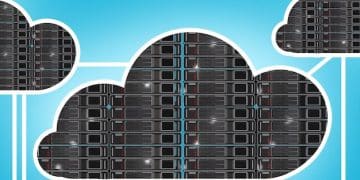Cloud Networking: Cut US Infrastructure Costs by 15% in 2025

Cloud networking offers US businesses a significant opportunity to reduce infrastructure costs by up to 15% in 2025 by leveraging scalable, flexible, and cost-effective solutions compared to traditional on-premises setups.
Are you a US-based business looking to slash infrastructure costs in 2025? How Cloud Networking Can Cut Your Infrastructure Costs by 15% in 2025: A US Guide unveils the strategies and benefits of embracing cloud-based networking solutions.
Understanding the Basics of Cloud Networking
Cloud networking is changing how businesses operate, particularly in the United States. It’s about moving your network infrastructure – routers, switches, firewalls – to the cloud. Let’s get a handle on the fundamental pillars of this technology.
What is Cloud Networking?
Cloud networking enables businesses to access network resources and services over the internet, eliminating the need for extensive physical infrastructure. This approach offers scalability, flexibility, and cost savings, leading to more affordable IT solutions.
Key Components of Cloud Networking
Cloud networking comprises several core components. Here’s an overview:
- Virtual Routers: Software-based routers that manage network traffic in the cloud.
- Cloud Firewalls: Security measures to protect cloud-based networks from threats.
- Software-Defined Networking (SDN): Technology that allows centralized control and automation of network resources.
- Virtual Private Networks (VPNs): Secure connections that enable private network access over the internet.
These components work together to create a resilient and scalable network infrastructure in the cloud.
Understanding these elements is the first step in leveraging cloud networking to reduce infrastructure costs.
The Financial Benefits of Cloud Networking
One of the most enticing aspects of cloud networking is the potential for significant cost savings. For US businesses, migrating to the cloud can unlock various financial advantages. Let’s dive into the dollars and cents.)

Reduced Capital Expenditure
With cloud networking, you don’t need to invest in expensive hardware like routers, switches, and servers. This dramatically reduces your upfront capital expenditure.
Lower Operational Costs
Cloud providers handle maintenance, upgrades, and security. This translates to lower operational costs. Here’s how:
- Reduced IT Staff: Less need for in-house IT staff to manage infrastructure.
- Lower Energy Bills: No need to power and cool racks of servers.
- Decreased Downtime: Cloud providers offer high availability and redundancy.
These savings accumulate over time, making cloud networking a cost-effective choice.
Cloud networking’s financial benefits are clear: reduced capital and operational expenses lead to significant cost savings for US businesses.
How Cloud Networking Can Cut Costs by 15% in 2025
The big question is: how can cloud networking specifically lead to a 15% cost reduction in 2025? The answer lies in leveraging the right strategies and technologies. Let’s explore the practical methods.
Optimizing Resource Utilization
Cloud networking enables you to scale resources up or down based on demand. This means you only pay for what you use, eliminating wasted capacity. For example, during off-peak hours, you can reduce resources to save on costs and avoid paying for what is not necessary.
Automating Network Management
Automation is a key component of cost reduction. Here are several areas where you can automate processes:
- Network Provisioning: Automatically configure network resources.
- Security Management: Automate threat detection and response.
- Performance Monitoring: Real-time insights to ensure optimal network performance.
These automations free up time and resources, allowing your IT team to focus on strategic initiatives.
By optimizing resource utilization and automating network management, you can achieve significant cost savings through cloud networking.
Cloud Networking Providers and Solutions for US Businesses
Selecting the right cloud networking provider is crucial. Several providers offer innovative solutions tailored to US businesses. Let’s check at the top players and their offerings.
Leading Cloud Networking Providers
Here are some of the prominent cloud networking providers in the United States:
- Amazon Web Services (AWS): Offers a comprehensive suite of networking services, including Virtual Private Cloud (VPC) and Direct Connect.
- Microsoft Azure: Provides Azure Virtual Network, ExpressRoute, and other networking solutions.
- Google Cloud Platform (GCP): Features Virtual Private Cloud (VPC), Cloud Interconnect, and Network Service Tiers.
Choosing the Right Solution
When selecting a provider, consider the following factors:
- Scalability: Can the solution scale to meet your business needs?
- Security: Does the provider offer robust security features?
- Integration: How well does the solution integrate with your existing infrastructure?
Carefully evaluate your options to find a provider that aligns with your business goals and offers the best value.
Selecting the right cloud networking provider and solution is a critical step in achieving cost savings and improving network performance.

Security Considerations for Cloud Networking
Security is paramount when moving your network to the cloud. Cloud networking introduces unique security challenges, so it’s vital to address them proactively. Let’s examine the essential security measures.
Understanding Cloud Security Threats
Cloud environments are susceptible to various security threats.
Implementing Security Best Practices
To mitigate these risks, implement the following security best practices:
- Multi-Factor Authentication (MFA): Enhance account security by requiring multiple forms of verification.
- Encryption: Protect data in transit and at rest with strong encryption.
- Intrusion Detection Systems (IDS): Monitor network traffic for malicious activity.
By prioritizing security, you can ensure the safety and integrity of your cloud network.
Addressing security concerns is crucial when adopting cloud networking. By implementing best practices, you can protect your data and maintain a secure environment.
Future Trends in Cloud Networking
Cloud networking is continuously evolving. Staying ahead of future trends will help US businesses optimize their network infrastructure and achieve greater cost savings. Let’s see how this technology continue improve.
Emerging Technologies
Keep an eye on these emerging technologies:
- 5G Integration: Enhanced connectivity and performance.
- Artificial Intelligence (AI): AI-powered network optimization and security.
- Serverless Networking: Simplified network management and scalability.
These trends promise to further enhance the capabilities and cost-effectiveness of cloud networking.
Preparing for the Future
To prepare for the future of cloud networking, consider the following steps:
- Continuous Learning: Stay informed about the latest trends and technologies.
- Strategic Planning: Develop a roadmap for adopting new technologies.
- Vendor Evaluation: Assess how your cloud provider is evolving and adapting.
By staying proactive, you can leverage these technologies to gain a competitive edge.
Future trends promise to revolutionize cloud networking, offering US businesses even greater capabilities and cost savings.
| Key Point | Brief Description |
|---|---|
| 💡 Cost Reduction | Cloud networking can cut infrastructure costs by 15% by 2025. |
| ☁️ Scalability | Easily scale resources up or down based on business demands. |
| 🔒 Security | Implement robust security measures like MFA and encryption. |
| 🤖 Automation | Automate network provisioning, security, and monitoring. |
Frequently Asked Questions (FAQ)
Cloud networking involves accessing network resources and services over the internet, eliminating the need for physical hardware. Traditional networking relies on on-premises hardware, requiring businesses to manage their infrastructure directly.
Cloud networking reduces costs through optimized resource use, lower capital expenditure, and reduced operational expenses. Automation and scalability enable efficient management and prevent overspending on resources.
Essential security measures include multi-factor authentication, encryption, intrusion detection systems, and robust access control policies. Regular security audits and compliance checks are also crucial for maintaining a secure cloud network.
Leading providers like AWS, Microsoft Azure, and Google Cloud Platform offer comprehensive networking solutions tailored for US businesses. The best choice depends on specific requirements, existing infrastructure, and business goals.
Emerging trends include 5G integration, AI-powered network optimization, and serverless networking. Businesses should focus on continuous learning and strategic planning to leverage these advancements effectively.
Conclusion
Adopting cloud networking presents a significant opportunity for US businesses to reduce infrastructure costs by 15% in 2025. By understanding the basics, leveraging the financial benefits, and prioritizing security, organizations can unlock the full potential of cloud networking and achieve greater efficiency.





